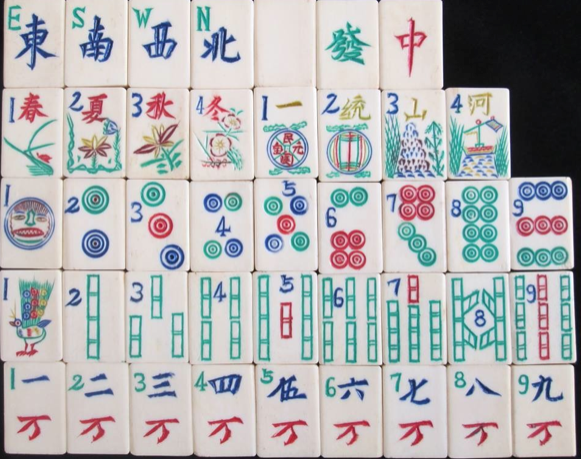A guest submission compiled by Katherine Hartman about a fabulous set in her collection, with very unusual One and 7 Dots and One Bam tiles. This set always makes me smile.
Katherine makes every effort to learn as much as possible about every set that comes her way.
Meet WILSON! I saw this set about a month ago on Ebay and had to have it. My son named the set, Wilson after Tom Hank's friend, Wilson the volleyball, in the movie, "Castaway". See the one dot, those of you have seen the movie will understand.
Michael Stanwick and Ray Heaton have had a very long look at the set. There was a very long discussion regarding the one flower that has the coin markings between the two of them. For all of you who are familiar with Michael's research, he has classified this set as a 1.1. Here are some of his thoughts:
"If you look at the way the 'West' and 'North' character are solidly engraved, and the position of all the cuts/strokes, you will see that they are identical to those seen in the 1875 Glover sets, the 1901 Laufer set and the 1909 Culin set. Compare these two characters to those found in the 1889 Wilkinson set and you will see they are different. Indeed, most sets have the N and S tile engravings that do not look like these old sets but look more like those in the Wilkinson set. (If you haven't got copies of The Playing-card journal you can see these sets on my web site.) Most of the sets in my collection that are in this 'old style' have these types of engravings and they tend to go hand in hand with the so-called pointed leaf shaped bamboos and with a String of Cash on the 1 bamboo. But what happened later was that these sets began to show hybridisation and so began morphing into unusual combinations of engravings - but still with these tell-tale N and S tiles AND the Seasons. Look at the Seasons in these pics. The engraving is bold and the characters are pretty large and in the middle vertical line of the tile. These are all indicators that this set was engraved by an engraver/manufacturer of the old style tradition or someone using the old style to engrave the set. My opinion is closer to the former... If you look at the red sinograms for the four seasons, you can see that they are fairly large with bold strokes (heavy strokes but with gusto! as opposed to the more restrained type of strokes seen in many other 1920's sets). In the Glover type sets you usually get the four seasons sinograms bang in the middle of the tile and with a frame of sorts around each one. In your case, we have pictures of plants sharing each tile but the sinograms are still on the centre vertical axis but not on the centre horizontal axis (since the picture has forced the sinogram up to the top. So there is still an acknowledgement that these sinograms should be in the centre of each tile and they made an effort to do so."
Ray THANK YOU for these translations of the flowers! From Ray:
一統山河
These are Yi Tong Shan He, or (word for word) One, Unite, Mountains and Rivers. Mountains and Rivers together is a way to refer to "the whole country", and so this phrase translates to "To unify the whole country" or a little more simply as "A united country". The other four show 春夏秋冬. These are Chun Xia Qiu Dong, Spring, Summer, Autumn and Winter (I suspect you recognized those!) And on the 1 Tile, reading top, bottom, right, left 民元 Min Guo Yuan Boa, Republic of China Silver Ingot. Such characters appear on coinage from the ROC period, but I don't see why this relates to the tiles.







